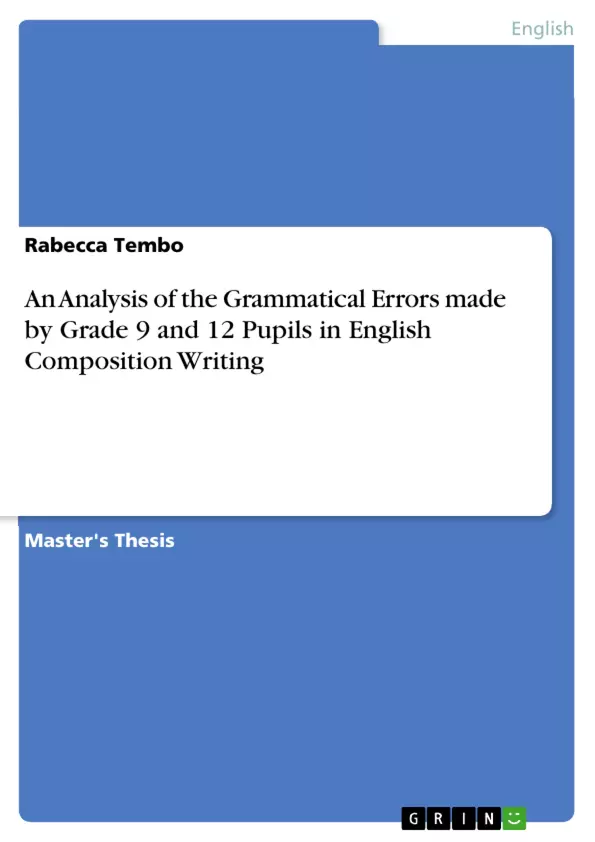This study has analysed the grammatical errors pupils make when writing English Compositions. This study paper aimed at investigating the grammatical errors committed by grade 9 and 12 pupils in English compositions. The study had the overall goal of identifying the kind of grammatical rules the pupils break. These errors hinder learners from understanding the language and sometimes block or slow down communication.
The objectives of the study were: to discover types of grammatical errors that learners make when writing compositions and 2. to discuss rules that were broken for pupils to commit such errors. The research design was a mixed method design which involved both qualitative and quantitative methodologies. Its targeted population was twenty-five (25) teachers of English and one hundred (100) grade 9 and 12 pupils from five selected secondary schools. Random sampling technique was used to arrive at Pupils to be included in the sample. Data for this research was collected using semi-structured interviews and written composition scripts. The compositions were marked with the help of other language teachers. Data was analysed and presented thematically using tables, graphs and discussions of findings. Composition scripts from the pupils were analyzed by looking at the types of errors made. The findings of the research revealed that the common grammar errors committed by secondary school pupils in Petauke District are: Verb tense, subject- verb agreement, pronoun, spellings, word order, and use of articles, double negative, preposition, and wrong word. It was also discovered that Pupils break grammar rules to make grammatical errors. The findings of this research may inform educators and language material developers about the grammatical errors pupils make and the rules they break to make such errors. The findings might also serve as guidance to teachers on how to assist learners to become better sentence writers. Ultimately, the project ends with conclusion and recommendations.
Table of Contents
- ACKNOWLEDGEMENTS
- DEDICATION
- DISCLAIMER
- LIST OF TABLES
- LIST OF FIGURES
- ACRONYMS AND ABBREVIATIONS
- ABSTRACT
- CHAPTER ONE
- 1.0 General
- 1.1 Introduction
- 1.2 Background
- 1.3 Statement of the Problem
- 1.4. Purpose of the study
- 1.5. Specific Objectives
- 1.6. Research Questions
- 1.7. Significance of the Study
- 1.8. Limitations
- 1.9. Delimitation
- 1.10. Conceptual Framework
- 1.11. Operational Definition of Terms
- CHAPTER TWO: LITERATURE REVIEW
- 2.0. General
- 2.1. Error and Mistake
- 2.2 Approaches to Error Studies
- 2.3 Studies on Grammatical Errors
- 2.4. Types of Grammatical Rules Commonly Broken According to Writers
- CHAPTER THREE: RESEARCH METHODOLOGY
- 3.0. General
- 3.1 Research Design
- 3.2 Research Methods
- 3.3 Research Instruments
Objectives and Key Themes
This dissertation aims to analyze the grammatical errors made by Grade 9 and 12 pupils in English composition writing. The study investigates the nature and frequency of these errors, exploring factors that may contribute to their occurrence. It also explores potential implications for improving English language proficiency in Zambian secondary schools.
- Grammatical errors in English composition writing by Grade 9 and 12 pupils
- Factors contributing to grammatical errors
- Types of grammatical errors
- Implications for English language proficiency
- Potential solutions to improve grammatical accuracy
Chapter Summaries
Chapter One introduces the study's context and purpose. It outlines the problem of grammatical errors in English composition writing among Grade 9 and 12 pupils, highlighting the significance of addressing this issue. The chapter also clarifies the study's objectives, research questions, and methodology.
Chapter Two provides a comprehensive review of relevant literature, discussing existing research on error analysis, grammatical errors in English as a Second Language (ESL), and pedagogical approaches to error correction. This chapter aims to establish a theoretical framework for the study.
Chapter Three focuses on the research methodology used in the study. It explains the research design, methods, and instruments employed to collect and analyze data on grammatical errors.
Keywords
This dissertation focuses on the analysis of grammatical errors in English composition writing by Grade 9 and 12 pupils in Zambia. Key concepts include error analysis, grammatical errors, English as a Second Language (ESL), language proficiency, and pedagogical approaches to error correction.
- Quote paper
- Rabecca Tembo (Author), 2020, An Analysis of the Grammatical Errors made by Grade 9 and 12 Pupils in English Composition Writing, Munich, GRIN Verlag, https://www.grin.com/document/979363




